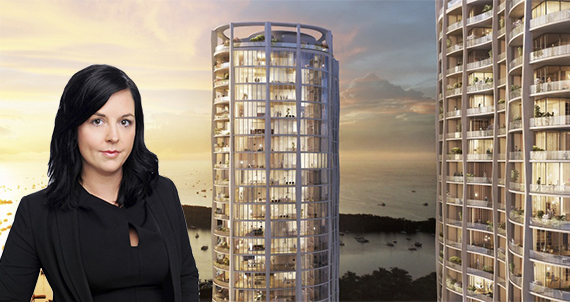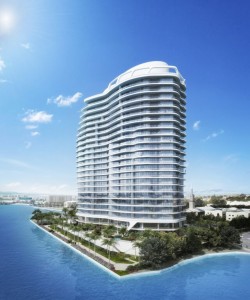Trending
Q&A with Elliman’s Susie Glass

Susie Glass, executive vice president of Sales and Marketing for Douglas Elliman Development Marketing, works on everything from hiring drone companies to recommending starchitects, all to create a brand.
Glass views development marketing teams as the behind-the-scenes project managers for a property.
She got her start in real estate about 10 years ago, in a career that has led her from Tony Cho’s Metro 1 to Alicia Cervera Lamadrid’s Cervera Real Estate, before joining Elliman in 2013.
“What’s different with most brands, is you build a brand to go on and on. With projects, once a developer sells out, it’s not his ongoing brand,” she told The Real Deal. “It’s a challenge we see with creative agencies. They want to build this brand that’s comparable with Nike, but it’s not going to be around for a hundred years. At the end of the day, the brand only lasts for so long.”
TRD sat down with Glass to discuss her role, redevelopment of the Shore Club and why water views are a part of all of Elliman’s South Florida projects.
What are your roles and responsibilities?
I oversee the day-to-day of the department, which is about 10 people right now, and the marketing for all of our projects. We have about $4 billion in active accounts from Coconut Grove to Palm Beach — not all of those are on the market. And we have $4 billion in the pipeline.
I make sure our clients are happy, that my team is working well — everything from overseeing media buys, managing the creative agencies, working with the rendering firms, the media buyers, the interior designers, the PR agencies, the developers. I understand sales, but I’m not a sales person.
[vision_pullquote style=”3″ align=””] “Real estate is part of the social fabric down here in Miami, whereas in New York you’ll probably be a little more challenged to get people to attend [parties]. Here, it’s kind of the thing to be invited to and the thing to do.” [/vision_pullquote]What goes into development marketing?
We will work with recommending interior designers, recommending architects, landscape architects. Most of the time, developers have their architect picked out or an architect they’ve already courted. Then, we get really involved in the identity of the building. What does the brand mean? Who is the audience we’re selling to? How do we want to position the project? Are we selling half the building before we launch it? Are we doing ads or not doing ads?
Then it comes to sales and launch. How are we going to launch the building? Are we going to wait for [Art] Basel, which is seems like everyone wants to do. Everyone’s target date is December, even though we say that they’re here to buy art. Events are a big part of it too. Real estate is part of the social fabric down here in Miami, whereas in New York you’ll probably be a little more challenged to get people to attend. Here, it’s kind of the thing to be invited to and the thing to do.
There are a lot of moving parts that are all working together and we’re kind of the project manager. It depends on the developer, and at the end of the day we give our advice on all of these things.
What about design?
The interior designers help create a story, and we try to work with a developer to find one that hasn’t been over-saturated in the market or is bringing something fresh, or aligns with the brand. Maybe we would go with a sustainably conscious architect if we were going for a LEED building. That’s not really a huge consideration because LEED isn’t sexy and developers do it because they have to, not because they really care to.
We do use drones a lot. Ultimately, our buyers care about the view, whether they’re on the beach, the bay, the Intracoastal. The views are really important.

Rendering of the Bristol Palm Beach
Who are your competitors?
I would say Sotheby’s is our main competitor.
Tell me about the Shore Club. How are you positioning the project?
Isay Weinfeld is the Brazilian architect and interior designer that’s going to go in there. We just wrapped up a six-figure lifestyle shoot with a famous photographer. Some developers wouldn’t pay that much for a lifestyle shoot. We avoid stock photography. It depends on the budget, the appetite, the market.
Our initial launch was during Art Basel, where we reserved 20 percent of the building in one week. We held the remaining units until we received all of the approvals and we will be releasing units in the next few weeks.
The thing about the Shore Club is that it’s on the 50-yard line of South Beach. It’s an amazing location. It has legacy. They’re not trying to do anything crazy with it. They’re removing the party and they’re adding some really tasteful design. They’re making it classier. There’s always going to be opposition from neighbors because they have their own interests, but we feel really comfortable with where it’s going.
[vision_pullquote style=”3″ align=””] “There are plenty of times where a man in a lesser position will be more respected or listened to by some developers simply because he’s a man. But not all of our developers are like that. ” [/vision_pullquote]What’s on the market now?
We have Park Grove by Rem Koolhaas; the Bristol in Palm Beach, which we have not launched to the public yet; Faena Contemporary and Versailles; The Residences at the Miami Beach EDITION; David Martin’s Eighty Seven Park at 8701 Collins Avenue; and three more we haven’t announced.
How did you get into real estate?
I started in real estate 10 years ago when Tony Cho opened his doors at Metro 1. I was one of his first employees and I worked with Tony tirelessly for five-and-a-half years. He was really important for my career because he really pushed me to get my LEED accreditation. He really had a vision for green building and we worked really well together.
I left because I was considering law school. I got accepted and Alicia Cervera called me around the same time. I was hired to help bridge the gap between Cervera and Related Cervera. I stayed with them and they started launching projects in August of 2011. All of the sudden, boom, we were getting all of these projects.
It was at that time, when I started looking at grad school, I found a program at NYU that worked with my schedule to get my master’s in real estate development. I got in touch with someone at Elliman and was hired. It made better sense for me personally to be with Elliman. I wasn’t really involved in those social circles at Cervera.
What challenges have you faced as a woman in the industry?
In real estate, you’re in a sea of suits. You can’t get deals done on the golf course or the strip club unless you’re really into that. I can’t really participate in that and also, I’m very young. There are plenty of times where a man in a lesser position will be more respected or listened to by some developers simply because he’s a man. But not all of our developers are like that. At the end of the day, we still struggle to make what men make.
I see all of this as a learning experience for what I want to do in my career, which is build my own buildings. Down the road, that’s really what I want.




